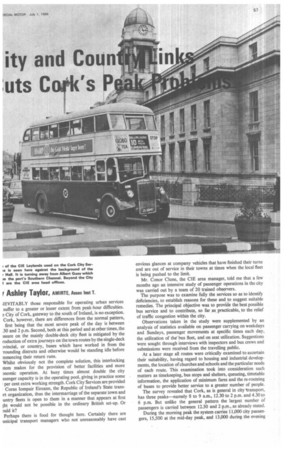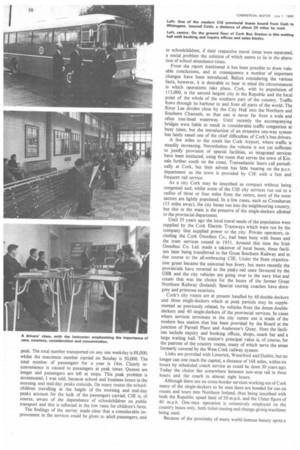ity and Coqn uts C 's
Page 59

Page 60

Page 61

If you've noticed an error in this article please click here to report it so we can fix it.
r Ashley Taylor, AMIRTE, Assoc lost T.
JEVITABLY those responsible for operating urban services suffer to a greater or lesser extent from peak-hour difficulties. e City of Cork, gateway to the south of Ireland, is noexception. Cork, however, there are differences from the normal pattern, first being that the most severe peak of the day is between .30 and 2 p.m. Second, both at this period and at other times, the !ssure on the mainly double-deck city fleet is mitigated by the roduction of extra journeys on the town routes by the single-deck wincial, or country, buses which have worked in from the rounding districts and otherwise would be standing idle before Timencing their return runs.
Whilst obviously not the complete solution, this interlocking ;tem makes for the provision of better facilities and more 3nomic operation. At busy times almost double the city ssenger capacity is in the operating pool, giving in practice some per cent extra working strength. Cork City Services are provided Coras Iompair Eireann, the Republic of Ireland's State transrrt organization, thus the intermarriage of the separate town and untry fleets is open to them in a manner that appears at first Olt would not be possible in the ordinary British set-up. Or mild it?
Perhaps there is food for thought here. Certainly there are unicipal transport managers who not unreasonably have cast envious glances at company vehicles that have finished their turns and are out of service in their towns at times when the local fleet is being pushed to the limit.
Mr. Conor Clune, the CIE area manager, told me that a few months ago an intensive study of passenger operations in the city was carried out by a team of 20 trained observers.
The purpose was to examine fully the services so as to identify deficiencies, to establish reasons for these and to suggest suitable remedies. The principal objective was to provide the best possible bus service and to contribute, so far as practicable, to the relief of traffic congestion within the city.
Observations taken in the study were supplemented by an analysis of statistics available on passenger carrying on weekdays and Sundays, passenger movements at specific times each day, the utilization of the' bus fleet, and on seat utilization. Suggestions were sought through interviews with inspectors and bus crews and submissions were received from the travelling public.
At a later stage all routes were critically examined to ascertain their suitability, having regard to housing and industrial developments, the location of churches and schools and the particular needs of each route. This examination took into consideration such matters as timekeeping, bus stops and shelters. queueing, timetable information, the application of minimum fares and the re-routeing of buses to provide better service to a greater number of people.
The survey revealed that Cork, as is general in city 'transport, has three peaks—namely 8 to 9 a.m.. 12.30 to 2 p.m. and 4.30 to 6 p.m. But unlike the general pattern the largest number of passengers is carried between 12.30 and 2 p.m., as already stated.
During the morning peak the system carries 11,000 city passengers, 15,500 at the mid-day peak, and 13,000 during the evening peak. The total number transported on any one weekday is 88.000, whilst the maximum number carried on Sunday is 50,000. The total number of passengers for a year is 14m. Clearly inconvenience is caused to passengers at peak times. Queues are longer and passengers are left at stops. This peak problem is accentuated, I was told, because school and business hours in the morning and mid-day peaks coincide. On many routes the schoolchildren travelling at the height of the morning and mid-day peaks account for the bulk of the passengers carried. CIE is, of course, aware of the dependence of schoolchildren on public transport and this is reflected in the low rates for children's fares.
The findings of the survey made clear that a considerable improvement in the services could be given to adult passengers, and to schoolchildren, if their respective travel times were separated, a social problem the solution of which seems to lie in the alteration of school attendance times.
From the report mentioned it has been possible to draw valuable conclusions, and in consequence a number of important changes have been introduced. Before considering the various facts, however, it is desirable to bear in mind the circumstances in which operations take place. Cork, with its population of 115,000, is the second largest city in the Republic and the focal point of the whole of the southern part of the country. Traffic flows through its harbour to and from all parts of the world. The River Lee divides close by the City Hall into the Northern and Southern Channels, so that one is never far from a wide and often tree-lined waterway. Until recently the accompanying bridges were liable to result in considerable traffic congestion at busy times, but the introduction of an extensive one-way system has lately eased one of the chief difficulties of Cork's bus drivers.
A few miles to the south lies Cork Airport, where traffic is steadily increasing. Nevertheless the volume is not yet sufficient to justify provision of special facilities, so integrated services have been instituted, using the route that serves the town of Kinsale further south on the coast. Transatlantic liners call periodically at Cork, but their advent has little bearing on the p.s.v. department as the town is provided by CIE with a fast and frequent rail service.
As a city Cork may be described as compact without being congested and, whilst some of the CIE city services run out to a radius of three or four miles from the centre, most of the outer sectors are lightly populated. In a few cases, such as Crosshaven (15 miles away), the city buses run into the neighbouring country, but this in the main is the preserve of the single-deckers allotted to the provincial department.
Until 35 years ago the local travel needs of the population were supplied by the Cork Electric Tramways which were run by the company that supplied power to the city. Private operators, including the Cork Omnibus Co., had been busy with buses and the tram services ceased in 1931. Around this time the Irish Omnibus Co. Ltd. made a takeover of local buses, these facilities later being transferred to the Great Southern Railway and in due course to the all-embracing CIE. Under the State organization green became the universal bus Livery, but more recently the provincials have reverted to the pinky-red once favoured by the GSR and the city vehicles are going over to the navy blue and cream that was the choice for the buses of the former Great Northern Railway (Ireland). Special touring coaches have dovegrey and primrose exteriors.
Cork's city routes are at present handled by 40 double-deckers and three single-deckers which at peak periods may be supplemented as previously related, by vehicles from the dozen doubledeckers and 40 single-deckers of the provincial services. In cases where services terminate in the city centre use is made of the modern bus station that has been provided by the Board at the junction of Parnell Place and Anderson's Quay. Here the facilities include inquiry and booking offices, shops, snack bar and a large waiting hall. The station's principal value is, of course, for the patrons of the country routes, many of which serve the areas formerly covered by the West Cork railway system.
Links are provided with Limerick. Waterford and Dublin, but no longer can one reach the capital, a distance of 168 miles, within six hours by scheduled coach service as could be done 30 years ago. Today the choice lies somewhere between non-stop rail in three hours and the coach in almost eight hours.
Although there are no cross-border services working out of Cork many of the single-deckers to be seen there are bonded for use on routes and tours into Northern Ireland, thus being inscribed with both the Republic speed limit of 50 m.p.h. and the Ulster figure of 40 m.p.h. One-man operation is extensively employed on the country buses only, both ticket-issuing and change-giving machines being used.
Because of the proximity of many world-famous beauty spots a igthy schedule of excursions is operated, using both coaches and most modern type of service bus. Tourist traffic varies greatly cording to season but a dozen or so vehicles are often employed this way with faring range from 7s. 6d. to 33s.
Integration between the city services and the other facilities forded by CIE appears to react helpfully all round and certainly ensure the availability of concessions that, viewed in the light of irely urban income and expenditure, undoubtedly would prove ieconomic. The traffic study to which reference has already been Lade revealed that at some times in the day the schoolchild content the passenger total was no less than 67 per cent, a figure that must ye rise to thought when it is considered that this traffic moved at ic lowest of commuter rates.
From the operator's angle one disadvantage of Cork's cornact layout is that a strong tradition exists for taking the miday meal at home, this applying not only to workers in general ut also to the schoolchildren. As a relatively high proportion f schools is located close to the city centre this tendency ccentuates the pressure and in fact creates a "peak within a eak" during which the return of the earlier lunchers gets eningled with the going-to-lunch trips of the later starters. During the period at which the study was made the city ,assengers amounted to some 80,000 daily. From figures that ave been examined, and from my own observations, it appears air to assume that many of the urban services can hardly be emunerative and that they must be of social value more than of commercial character. This is especially so on Sundays when
overall carryings fall by something like 40 per cent. Some journeys then are very lightly loaded, particularly in the morning, but there is a stronger call at times when worshippers are travelling to the 11 a.m. and noon services at the central churches.
The recent examination of passenger problems has revealed that in the public opinion there is room for improvement in the matter of queues and bus heating. So far as the latter is concerned a programme of interior heater installation is already in progress and it is to be continued until the entire tour fleet is so equipped. Completion is scheduled for the autumn.
Reports suggest that approximately 11 per cent of Cork's queueing passengers at peak times have had to wait for later buses because of queue-jumpers. Queueing indicator signs have been erected and discussions are taking place with corporation officials regarding the erection of queue barriers on a trial basis. The Garda (police) authorities have also been approached to assist in more orderly queueing arrangements. However, it has been noted that even since the erection of new queue signs there has been an improvement in the position.
During the survey it was revealed that members of the public generally were not clear about the times of buses and were inclined to come on a "hit or miss" basis, a fact that has led to misconceptions regarding the frequency of certain services. The erection at all terminal stops of boards with times of departure of all buses is now proposed. This has not been done previously owing to purposed route alterations. Furthermore, a copy of the Cork City timetables will be published at regular intervals.




























































































































